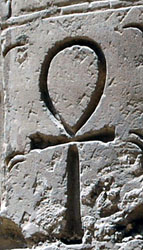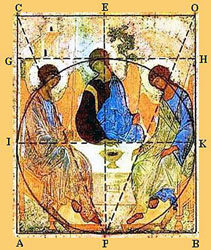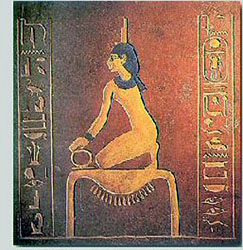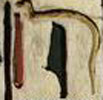The ancient civilisations arisen in the Mediterranean Basin have had common symbols which have crossed every border to diffuse in the whole world.
The evolution of human culture, which witness still today with architectonic evidence, began with the age of the Lion to continue with that of Twins, then the one of Taurus, of Aries, of Pisces to achieve now the Aquarius age. Taking the example of the period of the Taurus age, peoples who have lived in that time have shared the same cults even if geographic distances between them were enormous: in Crete with Tauromachy, in the Nuragic civilization with the cult of Taurus and the Mother Goddess, in Egypt with the representation of maximum protection in Hator with the mask of Cow and the cult of Api’s Bull.
The symbolism that unites these different populations appears as a phenomenon of simultaneous knowledge despite the distances imposing that separated them.
The Symbols have both joined, in the same project of growth, peoples with different languages and locations.
This happened for example, between the Egyptian script and the ancient Japan: both were using ideograms that were written starting from the top down, and both from left to right and right to left in the hieroglyphics.
In ancient land of Mishraim, today’s MSR, for us Egypt, this scripture on both sides served to make known the texts to scan inside a sacred site offering them to the attention of both those who acceded to the left and who entered from the right side and was used, for example, in vertical within the tombs.
Often the ideograms will unite phonetic signs, syllables but never vowels. For the ancient scribes was necessary to reproduce with accuracy the hieroglyphs (from the Greek hieros= sacred, glyphein=to carve) in order not to alter their symbolism and their ability to communicate, to make known to man the knowledge related to them.
A subtle irony would pass through the ancient writing to give the key to a second reading, so the ideogram of a swallow in hieroglyph means “the favourite” … you will agree with me that the small and tireless bird, able to cross the Mediterranean Sea to reach to the Nile, holds all the quality that the Bride of the Pharaoh was supposed to have (tenacity, courage and humble elegance).

I will try now to inspire in the reader love towards this ancient form of writing by putting at his attention the mutual relation between some of the main ideograms.
1) the ideogram “mer” (portrayed as a plough, hoe-compasses)

It means to love but also to cultivate, to prepare the field, designing (drawings of Architects). Only if you love you think to the future.
2) the ideogram “Seshem” ( portrayed as a seed with foot and sprout)
It means to drive, to lead, to instruct (who has knowledge and proposes it needs a certain time to see it treated and able to produce fruits), the more you will find fertile ground the more rapid will be growth. The same concept will be repeated in Marco Evangelion at Chapter 4.
3) the ideogram “Ank, anch” (portrayed as a ansate cross)

For the ancient Egyptians meant “The key of life”, represented the lace of the sandal that allows you to make your way walking.
The physicist Fritjof Capra has expounded in the ‘90s his theory trying to explain the phenomenon of “life” with the name of “bootstrap” that’s to say the sandal lace.
“Ank” was also a mirror of copper with which giving light to our own existence…to reflect!
From which it follows the need not to misrepresent our own status in the name of appearance and the need of introspection, the so neglected “look inside ourselves”.
In the Nuragic culture of Neolithic Age was the “Mother Goddess”, where the seed of knowledge can best take root, the raising of man towards Spirit.
4) the ideogram “di, dy” (portrayed as a triangle with a small opening on the basis)


means to give, to have, to be endowed, provided.
It is important to focus on the mutual relation among the 3 states: you cannot give if you
haven’t got, you are not provided with if you haven’t given, and…you haven’t got if you are not provided with.
The number 3 is the symbol of perfection since the beginning of the times.
Nowadays it symbolizes the Christian Catholic and Orthodox Trinity.
Catholic Example:
during the baptism in the first centuries AD, the catechumen was plunged three times as the Triduum (three days) passed by Christ in the tomb.
Orthodox Example:
in the “Icon of the Trinity” of the Russian Andrè Roublev the representation takes place within a triangle enclosed in a circle which accidental point is not, as in the normal perspective, turn to the background of the painting but goes towards the spectator. We should note how even in this work of art we can see the symbol of the small door open.

Also in the “Law” of the Jewish the triangle is present in the prayer “Trisagion” whose words are: “God holy, strong holy, immortal holy have mercy on us”
This holiness is repeated three times to show his absolute, his completeness, his eternity.
The three sides of the triangle appear in choreography of the Three Graces painted in ancient Pompei, subject resumed in the Renaissance, at the Court of Lorenzo the Magnificent.


Three Graces from Pompei till Botticelli
A Grace gives, the other receives and gives and the third hands back equal gift to the first. Equally our arms should be open to embrace our similar, a movement as towards the person we offer as to whom gives us back the benefit that we, with our initial offer, have stimulated.
The generous can thus take the risk to receive what has donated while the niggar can only lose!
The Three Graces indicate by millennia as this attitude cannot be disregarded by the correct human evolution.
Artists such as Valeriano, Raffaello, Botticelli, Correggio, Veronese have celebrated the Three Graces in their paintings together with those reproduced by minting die in celebrative coins (Medal of Pico della Mirandola at the time that was young student of Ficino), to those printed in the ex-libris (Johannes Cuspinianus), or even portrayed in popular Tarot cards.
Only in our time we have managed to escape the importance symbolized by triad: absolute need to proceed not only towards our neighbour but also towards the Third, the other.
Human essence is innate in the number three and not in the one! The one is trine.
Testimonials are found in the text (published in 1499 d.c. by Francesco Colonna) “Hypnerotomachia Poliphili”, whose title is a word invented composed of Greek terms Hypnos (sleep), Erotos (Lovers), and Machia (fight), with the precious xilographies of Mantegna, Bellini and Raffaello

In the work the protagonist Polifilo is taken to the three doors that mark the passage from a land to another by two female figures: Logistica ,the Rationality and Telemia , the Will ( The Human being who becames spirit).
During the journey he will meet hieroglyphics and Egyptians monuments to Trinity: the obelisk, the tip of which ends with the piramidon, which represents the junction to the absolute and a pyramid set above a cube, which draws its attention on the Trinitarian quality of the Being.
It must therefore not to be forgotten the eliopitan cosmogony, (Eliopoli = On in the Biblical texts), with the triad represented by Shu, the air with the feather of Maat, Tefnut–nut the moisture, Geb the earth (Neolithic, the Bronze Age) that form the three parts of the primordial world.

5) the ideogram “shenu” (portrayed as a cartouche)

It symbolize the protection, to take care of, to preserve.
The word “Eka” (a papyrus enclosed by infinity) , on the other hand, means till the present days to keep together what is enclosed in knowledge: Library ( Bibloteca), Picture-gallery (Pinacoteca), Wine-shop (Enoteca), Recreation centre (Ludoteca).
Shenu has therefore a higher meaning because the points of the circle are in continuous evolution without end and without a beginning, forever.
The circle has always been symbol of holiness and eternity: for example it is the sun behind the Egyptian statues, it’s the halo of our saints, the background behind the statues of Buddha.
The form of the circle, which enlarged to form a cartouche was used to protect one of the five names of the Pharaoh, should be correlated with the word “religion” and its meaning of binding together, religere.
We must do a quick note on the importance of knowledge of the words: for example if you compare “to divide” with “to share”.
One year is represented in 12 months, it’s not divided in 12 months in that each month is part of the same totality, it is therefore shared.
The differences of a society are its wealth, but the divisions in the same represent its poverty because what is divided is not part of the same idea, of the same project.
We must therefore learn to give a great importance to the words and to what they represent.
6) the ideogram “medu” (portrayed as a knotty stick).

It means the words. During the journey of this life the words (the stick) are a support, they help to avoid every danger, but you must give full attention in using them. They may be dangerous, cause shocks and even death if you use them without knowledge.
The ancient Egypt recognized great importance to the silence; prolixity and chattering were considered capital faults.
In the work of the eleventh century A.C. kept in the Museum of Moyen Age of Cluny in Paris called “Antipodio of the Cathedral of Bâle”, in the engraving are present three different idioms.

The sentence “ AQUIS SICUT HEL FORTIS MEDICUS SOTER BENEDICTUS” ( on the top line) “A PROSPICES TERRI GENAS CLEMENS MEDIATOR USIAS” ( in lower line) is the antidote to Babel as reconciles in Christ the writings, then the cultures, that preceded him: in chronological order the Hebrew, Greek and Latin.
Account should be taken that the Ptholomei (from Ptha, the supreme representative of the eliopitan knowledge) 305 b.C./30 b. C., having conquered Egypt with the campaign of Alexander the Great, spoke and wrote both in Greek and in ancient Egyptian. It was as a result of this peculiarity that Champoillon has managed, with the discovery of the Rosetta Stone, to interpret the translation of hieroglyphics.
(see art 19 l’Istrice]
7) the Ideogram “Moses” (portrayed as three skins of animal linked).

It means born. For the Ancient the birth was considered the emission from three packaging: the sky, the world of the middle and the earth.
Once again the number three embodies a totality well built, the triangle, the pyramid. [ndr: Moses, committed to the waters of the Sacred Nile, was found and adopted at the Court of the Pharaoh with this name]
8) The ideogram “Pàr (fàr in Italian)” portrayed as a square with an opening)
It means house. The name Pharaoh derives from the union of Pàr (home) and Ra (sun) formerly it was read Pàra, Fàra
The origins of Paris, the ancient Lutece Parisis, which rose on the island of Saint Louis are more ancient than what we can imagine: under the foundations of Lutece there are altars of the ancient Egyptians dedicated to Isis!
Paris deriva da Pàr (home) of Isis, that has to be read Parisis .
On the end we shall make a short account on the importance of colours: blue has always been joined with divinity, red with spirit, gold yellow with illumination.
Often the Mother of God is represented with the colour blue, almost with nocturnal tones which contrast with the faint light of her face enlightened. That has in the Christian symbolism the meaning of “She who leads the sun that rises to come to visit us. Luc 1.78”

Similarly, in ancient Egypt, Nut, which represents the atmosphere and the protection, welcomes in her the sun for the entire period of the night to give it back to a new life at world dawn. In a similar way also we are asked to accept everything we understand and all we are still not able to realize: this is the role of our faith.



